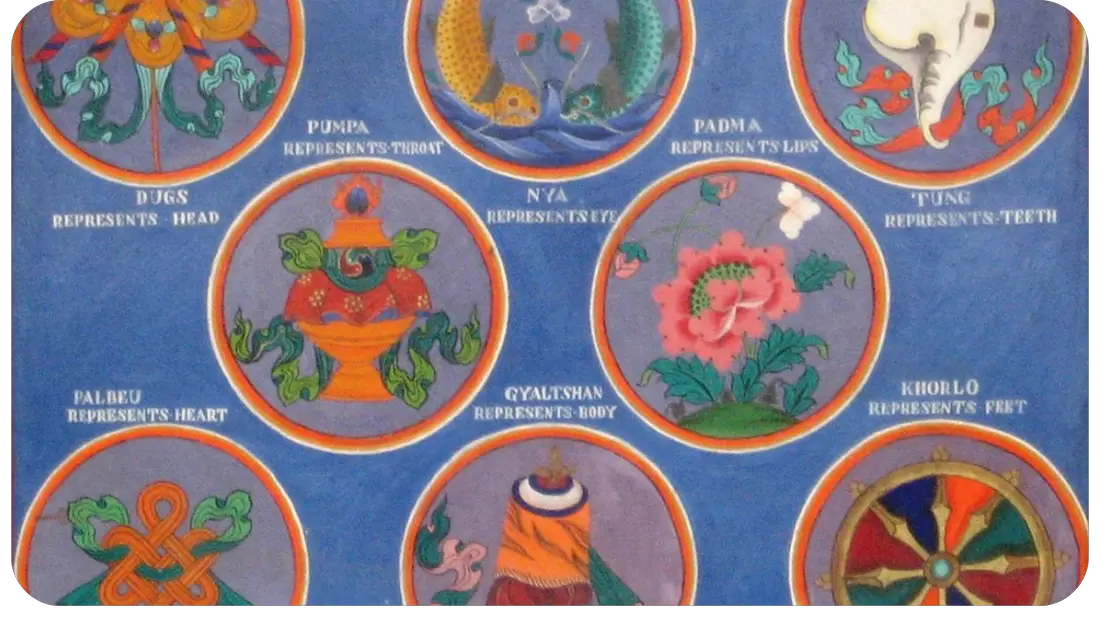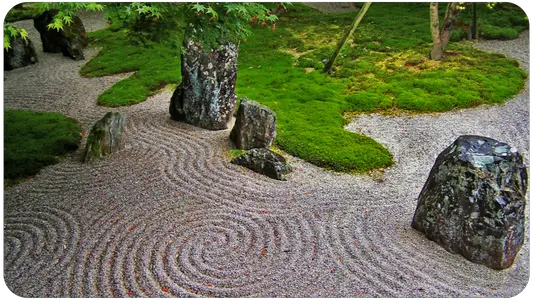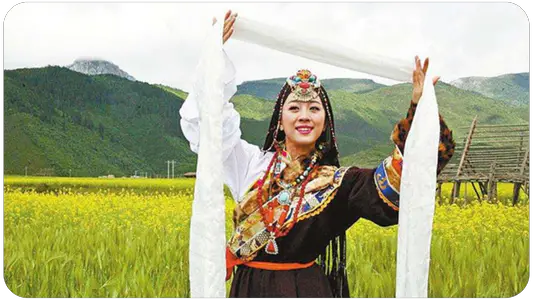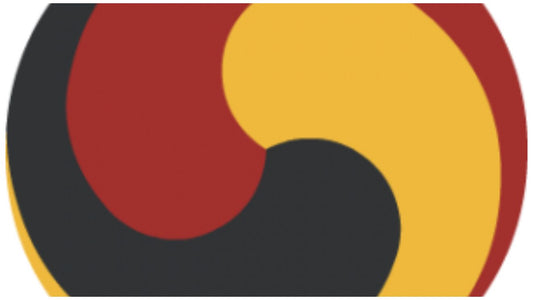Ashtamangala (Sanskrit: अष्टमंगल, IAST aṣṭamaṅgala, Devanagari: अष्टमंगल, Tibetan: བཀྲ་ཤིས་རྟགས་བརྒྱད་, Wylie: bkra shis rtags brgyad, Tibetan pinyin: Zhaxi Dag'gyä, Lhasa dialect API: tʂáɕitaʔ cɛ̀ʔ: Tashi Ta-gyé; simplified Chinese: 佛门八宝; traditional Chinese: 佛門八寶; pinyin: fómén bābǎo ) refers to a group of eight (ashta) auspicious symbols (mangala) in Hinduism, Buddhism, Jainism and Sikhism. The nature and order of the elements may vary.
The most widely circulated list in the twenty-first century is that of Buddhism, particularly visible in the vajrayāna.
The eight symbols first appear in India in royal investiture ceremonies. An ancient list enumerates a throne, a swastika, a handprint, a knot, a treasure urn, a ewer, a pair of fish, a covered bowl.
In Buddhism, the symbols are the conch, the parasol, the fish, the urn, the wheel, the banner, the lotus, the knot. They were offered by the devas to the Buddha at his birth in recognition of his "royalty".
Symbols in Buddhism
The dextrous white conch (sk. shankha, tib. dundkar) is the trunk of the heroes in Indian epic literature. The Panchajanya conch "which controls the five kinds of beings" is one of the attributes of the Hindu deity, Vishnu. In Buddhism it represents the voice of the Buddha and his teaching.
The endless knot (sk. Shrivatsa, tib. palbe) can also be shaped like a flower. It was originally a symbol of love. The Shrivatsa appears on the chest of Vishnu, of which it is one of the names, in the place where his goddess Lakshmi resides.
This symbol, however, bears no resemblance to the "endless knot" of Buddhism. It will also appear on Kalki's chest. In Buddhism it represents the mind of the Buddha as well as the interdependence of all things, the union of compassion and wisdom, wisdom and means, or emptiness and interdependence.
The pair of fish (sk. matsyayugma, tib. sergyna) originally represent the Ganges and the Yamuna. In yoga they also symbolize the lunar and solar channels (nadi) and vitality (prana). In Buddhism they represent the vision of the Buddha as well as the ability of beings on the path to evolve towards liberation without drowning in samsara.
The lotus (sk. padma, tib.pema) represents divine beauty and purity. It is one of the attributes of Vishnu. Hindu deities, Buddhas and Bodhisattvas are often represented sitting on lotus flowers. In Buddhism, the lotus represents the tongue of the Buddha and the purification of the body, speech and mind.
The parasol (sk. chatra, tib. rinchen dug) was in India an attribute of royalty. In Buddhism, it represents the head of the Buddha and protection from material and spiritual dangers.
It can also represent the sky and the ether in the Mahabhuta system of the five elements. Some have suggested that it could also represent a mushroom in the Himalayan pharmacopoeia.
The treasure urn (sk. kalasha, tib. བུམ་པ་ bumpa) represents material (health, longevity, material ease) and spiritual benefits. In Buddhism, it represents the neck of the Buddha, and the water pot that is part of the monk's possessions, or a vessel containing wisdom used in vajrayāna anointing ceremonies. It represents space in the mahabhuta series of the five elements.
The wheel (sk.chakra, tib. khorlo) representing the chariot is an attribute of royalty. The term chrakravartin, "the one whose wheels turn", refers to a great ruler whose chariot meets no barrier. The chakra is a kind of circular weapon that is one of the attributes of Vishnu.
The dharmachakra wheel is the best known symbol of Buddhism where it represents, as in Jainism, the teaching of the doctrine and the union of all things. It can appear as a motif in the footprint of Buddha.
In some representations, the Buddha or Maitreya make the dharmachakra gesture which represents the setting in motion of the wheel of the Law: the right palm turned outwards, the left upwards, thumb and forefinger joined forming two circles.
In Nepal, the chamara flycatcher, a badge of dignity , replaces the wheel in the list of eight symbols. Made of yak hair on a silver handle, it is a ritual object that represents tantric manifestations.
The banner (sk. dhvaja, tib. gyaltsen) has the shape of a rolled up flag which represents victory, it is an attribute of royalty. The Makara banner has become the emblem of the god of love Kama. In Buddhism it represents the body of the Buddha, and victory over negative forces such as the māras. In Tibetan Buddhism there are eleven different forms of banners representing the eleven methods of fighting negative forces.
Different lists and orders
Tibetan Buddhism
Knot, lotus, banner, wheel or chamara flycatcher (Nepal), urn, fish, parasol, conch shell.
In China during the Qing dynasty :
Wheel, conch, banner, parasol, lotus, urn, fish, knot.
Jainism
Digambara tradition of Jainism:
The parasol (chatra), the banner (dhvaja), the vase (kalasha), flycatcher (chamara), the mirror (Darpana), the throne (Supratistha), 'fan (vyajana), the golden vase (Bhringara).
Shvetambara tradition of Jainism:
Swastika, the knot-shaped lozenge (Shrivatsa), the nine-fold symbol (nandavarta)[unclear], the luminous dishes (vardhamanaka), the throne (bhadrasana), the vase (kalasha), mirror (darpana), the two fish (Matsyayugma).
Hinduism
North Indian traditions, sample list:
Lion, bull, elephant, ewer, vase , flycatcher, banner, conch, oil lamp.
Traditions of South India, example of list :
Flycatcher, vase, mirror, mahout spur, oil lamp, banner, pair of fish.





